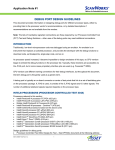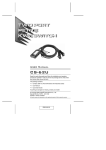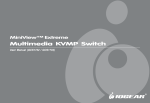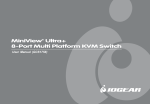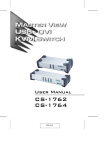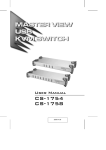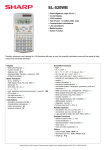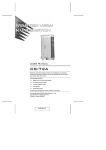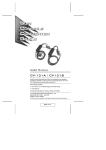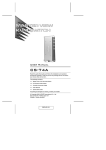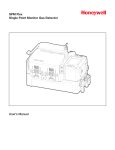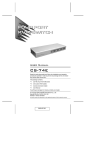Download ATEN CS-64U User manual
Transcript
User Manual CS-64U Read this guide thoroughly and follow the installation and operation procedures carefully in order to prevent any damage to the units and/or any devices that connect to them. This package contains: M 1 CS-64U USB KVM Switch with Attached Cables M 1 User Manual M 1 Quick Start Guide If anything is damaged or missing, contact your dealer. © Copyright 2004 ATEN® International Co., Ltd. Manual Part No. PAPE - 1248-100 Printed in China 06/2004 All brand names and trademarks are the registered property of their respective owners. 2004-06-10 Note: This equipment has been tested and found to comply with the limits for a Class B digital device, pursuant to Part 15 of the FCC Rules. These limits are designed to provide reasonable protection against harmful interference in a residential installation. This equipment generates, uses and can radiate radio frequency energy, and if not installed and used in accordance with the instruction manual, may cause interference to radio communications. However, there is no guarantee that interference will not occur in a particular installation. If this equipment does cause harmful interference to radio or television reception, which can be determined by turning the equipment off and on, the user is encouraged to try to correct the interference by one or more of the following measures: M Reorient or relocate the receiving antenna; M Increase the separation between the equipment and receiver; M Connect the equipment into an outlet on a circuit different from that which the receiver is connected; M Consult the dealer or an experienced radio/television technician for help. 2004-06-10 Overview The CS-64U Petite USB KVM Switch is a control unit that allows access to four computer systems from a single console (keyboard, monitor, mouse and audio). Before the development of the CS-64U, the only way to control multiple computer configurations from a single console was through a complex and costly network system. Now, with the CS-64U, you can easily access four computers in a cost effective manner. The CS-64U improves on previous models by transferring keyboard and mouse data to the computers via the faster, more reliable USB bus rather than the traditional PS/2 connection. Additionally, its incredibly small desktop footprint and molded-in custom KVM cables provide a hassle-free installation and a neat and tidy workspace. Recognizing the benefit of sound in the computing environment, the CS-64U provides USB multimedia keyboard support, and is speaker enabled. You can independently listen to the audio output of any of the computers (one-at-a-time) with a single set of speakers regardless of where the KVM switch focus is at. Setup is fast and easy; plugging cables into their appropriate ports is all that is entailed. There is no software to configure, no installation routines, and no incompatibility problems. Since the CS-64U intercepts keyboard input directly, it works on any hardware platform and with all operating systems. KVM focus is toggled between the computers by means of simple Hotkey combinations entered from the keyboard. There is no better way to save time and money than with a CS-64U USB Mini-KVM Switch installation. By allowing a single console to manage all of your computers, the CS-64U eliminates the expense of purchasing a seperate keyboard, monitor, mouse and speakers for each. Additionally, it saves the extra space they would take up, and eliminates the inconvenience of constantly having to move from one computer to the other. -1- 2004-06-10 Features M One console (VGA, SVGA or Multisync monitor, a USB keyboard, and a USB mouse) controls up to four computers M Compact and small footprint design features four molded-in KVM (Keyboard, Video, Mouse and audio) cables M Easy to install: no software required - connecting cables to the computers is all it takes M Easy to operate - computer selection via hotkeys - auto scan function to monitor computer operations M Keyboard and mouse emulation - computers can boot even when the console focus is elsewhere M Hot pluggable - add or remove computers for easy maintenance M Power on detection - automatically switches to the first powered on port M Caps Lock, Num Lock, and Scroll Lock states are saved and restored when switching M LED display for easy status monitoring M Hotkey selection for OS 1 M Supports multimedia USB keyboards M Supports Logitech and Microsoft wireless keyboards and mice M Supports 4 and 5 button mice and the scrolling wheel on most mice2 M Superior video quality - supports resolutions of up to 2048 x 1536; DDC2B M Speaker enabled for audio sharing M Supports Windows 98SE or higher, Mac OS 8.6 or higher, Sun Solaris 8 or higher and Linux RedHat 7.1 or higher M Non Powered 1 With proper driver installed. 2 A mouse driver installed with the operating system is required for the 4th and 5th button functions. -2- 2004-06-10 Hardware Requirements Console M A VGA, SVGA, or Multisync monitor capable of the highest resolution that you will be using on any computer in the installation M A USB Keyboard M A USB Mouse Computers The following equipment must be installed on each computer that is to be connected to the system: M A VGA, SVGA or Multisync port M A USB type A port Cables For optimal signal integrity and to simplify cable management, four high quality 3-in-1 CS Custom KVM cables have been designed into the CS-64U. There is no need for a separate cable purchase. System Requirements M OS: USB enabled OS M USB Host Controller installed on the system. -3- 2004-06-10 Top View 1 2 3 4 1. KVM Cables These 3-in-1 cables connect to the USB, video, and audio ports on the computers you are installing. The cable with a single dot at its base is the Port 1 cable; the cable with two dots at its base is the Port 2 cable, etc. 2. Port LEDs A LED lights to indicate its corresponding port is the one that has the KVM focus. The LED that has one dot represents Port 1; the LED with two dots represents Port 2, etc. Depending on the port’s status, the LED may flash according to a specific pattern (see the LED Display Table, p. 17, for details). 3. Speaker Jack The cable from your speakers plug in here. 4. Console Ports Your keyboard, monitor, and mouse plug in here. -4- 2004-06-10 Installation 1. Make sure that power to all the devices you will be connecting up has been turned off. You must unplug the power cords of any computers that have the Keyboard Power On function. 2. Make sure that all devices on the installation are properly grounded. Refer to the installation diagram on the next page as you perform the following: 1. Plug your keyboard, monitor and mouse into their ports on the CS-64U. The keyboard and mouse ports are labeled with an icon to distinguish them. Note: When using a wireless composite keyboard and mouse, its USB cable must plug into the CS-64U’s keyboard port for the hotkeys to function. 2. Plug your speakers into the CS-64U’s speaker jack. 3. Plug the USB, video, and speaker connectors of the attached KVM cables into their respective ports on the computer you are installing. Note: The computer attached to the cable with one dot at its base is the Port 1 computer; the computer attached to the cable with two dots at its base is the Port 2 computer, etc. (see p. 7 for hotkey port selection). 4. Turn on the power to the computers. Note: The CS-64U’s Power On default is to link to the first computer you turn on. -5- 2004-06-10 2 1 3 -6- 2004-06-10 Hotkey Operation The CS-64U provides an extensive, easy-to-use, hotkey function that makes it convenient to control and configure your KVM installation from the keyboard. Hotkeys provide asynchronous (independent) switching of the KVM console and the audio focus. If you wish, you can give one computer the KVM console focus and another computer the audio focus. Port Switching All port switches begin with tapping the Scroll Lock key twice. The tables below describe the actions that each combination performs. Note: If using the Scroll Lock key conflicts with other programs running on the computer, the Ctrl key can be used, instead. See p. 10 for details. Cycling Through the Ports Hotkey [Scroll Lock] [Scroll Lock] [Enter] Action Brings the KVM and the audio focus from the port that currently has the KVM focus to the next port on the installation (1 to 2; 2 to 3; 3 to 4; 4 to 1). Note that the KVM, and audio focus all go to this port even if they were on different ports to begin with. [Scroll Lock] [Scroll Lock] [K] [Enter] Brings only the KVM focus from the port that currently has it to the next port on the installation. The audio focus remains where it is. [Scroll Lock] [Scroll Lock] [S] [Enter] Brings only the audio focus from the port that currently has it to the next port on the installation. The KVM focus remains where it is. -7- 2004-06-10 Going Directly to a Port Hotkey [Scroll Lock] [Scroll Lock] [n] [Enter] Action Brings the KVM and the audio focus to the computer attached to the port corresponding to the specified Port ID. Note that the KVM and audio focus both go to this port even if they were on different ports to begin with. [Scroll Lock] [Scroll Lock] [n] [K] [Enter] Brings only the KVM focus to the computer attached to the specified port. The audio focus remains where it was. [Scroll Lock] [Scroll Lock] [n] [S] [Enter] Brings only the audio focus to the computer attached to the specified port. The KVM focus remains where it was. Note: The n stands for the computer’s Port ID number (1, 2, 3, or 4). Replace the n with the appropriate Port ID when entering hotkey combinations. The K stands for the KVM switch focus The S stands for audio focus -8- 2004-06-10 Auto Scanning The CS-64U’s Auto Scan feature automatically cycles the KVM focus through the computer ports at regular intervals. This allows you to monitor the computer activity without having to take the trouble of switching from port to port manually. See the table below for details. Hotkey Action [Scroll Lock] [Scroll Lock] [A] [Enter] Starts Auto Scan. The KVM focus cycles from port to port at 5 second intervals. [Scroll Lock] [Scroll Lock] [A] [n] [Enter] Starts Auto Scan. The KVM focus cycles from port to port at n second intervals. Note: 1. The n stands for the number of seconds that the CS-64U should dwell on a port before moving on to the next. Replace the n with a number between 1 and 99 when entering this hotkey combination. 2. While Auto Scan Mode is in effect, ordinary keyboard and mouse functions are suspended - only Auto Scan Mode compliant keystrokes and mouse clicks can be input. You must exit Auto Scan Mode in order to regain normal control of the console. To exit Auto Scan Mode, press [esc] or [Spacebar]. -9- 2004-06-10 Hotkey Setting Mode Hotkey Setting Mode is used to set up your CS-64U switch configuration. All operations begin with invoking Hotkey Setting Mode (HSM). Invoking HSM To invoke HSM do the following: 1. Press and hold down the Num Lock key 2. Press and release the minus key 3. Release the Num Lock key Note: The minus key must be released within one half second, otherwise Hotkey invocation is canceled. When HSM is active, the Caps Lock, and Scroll Lock LEDs flash in succession to indicate that HSM is in effect. They stop flashing and revert to normal status when you exit HSM. Ordinary keyboard and mouse functions are suspended - only Hotkey compliant keystrokes and mouse clicks (described in the sections that follow), can be input. At the conclusion of some hotkey operations, you automatically exit hotkey mode. With some operations, you must exit manually. To exit HSM manually, press the Esc key, or the Spacebar. Alternate HSM Invocation Keys An alternate set of HSM invocation keys is provided in case the default set conflicts with programs running on the computers: 1. Invoke HSM (see above) 2. Press and release the H key The HSM invocation keys become the Ctrl key (instead of Num Lock) and the F12 key (instead of minus). Note: This procedure is a toggle between the two methods. To revert back to the original HSM invocation keys, invoke HSM, then press and release the H key again. - 10 - 2004-06-10 Alternate Port Switching Keys The port switching activation keys can be changed from tapping the Scroll Lock key twice ([Scroll Lock] [Scroll Lock]) to tapping the Ctrl key twice. To change the port switching activation keys, do the following: 1. Invoke HSM (see p. 10) 2. Press and release the T key Note: This procedure is a toggle between the two methods. To revert back to the original [Scroll Lock] [Scroll Lock] method, invoke HSM, then press and release the T key again. Keyboard Operating Platform The CS-64U’s default port configuration is for a PC Compatible keyboard operating platform. If your requirements call for different port settings (you have a Mac or Sun attached to a port, e.g.), you can change a port’s keyboard operating platform configuration as follows: 1. Bring the KVM focus to the port you want to set. 2. Invoke HSM (see p. 10) 3. Press and release the appropriate Function key (see table). After completing a setting, you automatically exit HSM. Function Key Operation [F10] Auto detects the keyboard operating platform (for PC compatible systems). [F2] Sets the Mac keyboard operating platform. [F3] Sets the Sun keyboard operating platform.* * The first time that the Sun system runs from a port, you must configure its port for the Sun keyboard operating platform before you turn the system on, or else the Sun system will not start. - 11 - 2004-06-10 List Hotkey Settings To see a listing of the current hotkey settings, do the following: 1. Invoke HSM (see p. 10). 2. Press and release the F4 function key. 3. Open a text editor or word processor and use its Paste function to display the settings. USB Reset If the USB loses focus and needs to be reset, do the following: 1. Invoke HSM (see p. 10). 2. Press and release the F5 function key. Hotkey Beeper Control The Beeper can be hotkey toggled On and Off. To toggle the Beeper, do the following: 1. Invoke HSM (see p. 10). 2. Press and release the B key. The Beeper toggles On or Off. The Command Line displays Beeper On or Beeper Off for one second; then the message disappears and you automatically exit Hotkey Mode. Disable Port Switching Keys To disable the Port Switching Keys ([Scroll Lock] [Scroll Lock] / [Ctrl] [Ctrl]), do the following: 1. Invoke HSM (see p. 10). 2. Press [X] [Enter]. Note: This procedure is a toggle. To enable the Port Switching keys repeat steps 1 and 2. - 12 - 2004-06-10 Restore Default Settings To reset the CS-64U to its default hotkey settings, do the following: 1. Invoke HSM (see p. 10). 2. Press [R] [Enter]. All hotkey settings return to the factory default settings. HSM Summary Table After invoking HSM (see p. 10), key in one of the following keys to perform the corresponding function: Key Function H Toggles between the default and alternate HSM invocation keys. T Toggles between the default and alternate Port Switching keys. F10 Auto detects the keyboard operating platform (for PC compatible systems). F2 Sets the Mac keyboard operating platform. F3 Sets the Sun keyboard operating platform. F4 Lists the current hotkey settings via the Paste function of a text editor or WP. F5 Performs a USB reset. B Toggles the beeper On and Off. X [Enter] Enables/Disables the Port Switching keys. R [Enter] Resets the hotkey settings to their default status. - 13 - 2004-06-10 Keyboard Emulation Mappings Sun Keyboard The PC compatible (101/104 key) keyboard can emulate the functions of the Sun keyboard when the Control key [Ctrl] is used in conjunction with other keys. The corresponding functions are shown in the table below. Note: When using [Ctrl] combinatons, press and release the Ctrl key, then press and release the activation key. PC Keyboard Sun Keyboard [Ctrl] [T] Stop [Ctrl] [F2] Again [Ctrl] [F3] Props [Ctrl] [F4] Undo [Ctrl] [F5] Front [Ctrl] [F6] Copy [Ctrl] [F7] Open [Ctrl] [F8] Paste [Ctrl] [F9] Find [Ctrl] [F10] Cut [Ctrl] [4] Power [Ctrl] [H] Help [Ctrl] [1] Mult [Ctrl] [2] V_DN [Ctrl] [3] V_UP [Win] Compose - 14 - 2004-06-10 Mac Keyboard The PC compatible (101/104 key) keyboard can emulate the functions of the Mac keyboard. The emulation mappings are listed in the table below. Note: When using key combinatons, press and release the first key, then press and release the second one. PC Keyboard Mac Keyboard [Shift] Shift [Ctrl] Ctrl [Win] [Ctrl] [4] [Alt] L Alt/Option [Prt_Sc] F13 [Scroll Lock] F14 [Desktop Menu] = [Enter] Return [Back Space] Delete [Ins] Help [Ctrl] [Win] F15 [Ctrl] [1] Mult [Ctrl] [2] V_DN [Ctrl] [3] V_UP - 15 - 2004-06-10 Appendix Specifications Function Specification CPU Ports 4 Port Selection Hotkeys CPU USB Connectors VGA 4 x Type-A (M) Speaker Console Keyboard Connectors Mouse 4 x HDB-15 (M) 4 x Audio Jack (M) 1 x Type-A (F) 1 x Type-A (F) VGA 1 x HDB-15 (F) Speaker 1 x Audio Jack (F) LEDs 4 x Green Keyboard / Mouse Emulation USB (PC, Mac, Sun) Scan Interval 5 Seconds Resolution 2048 x 1536, DDC2B Power Mode Bus powered Operating Temperature 0o C - 50o C Storage Temperature -20o C - 60o C Humidity 0 - 80% RH Noncondensing Housing Plastic Weight 800g Dimensions (L x W x H) 109.1 x 97.23 x 25.45 mm - 16 - 2004-06-10 Troubleshooting Symptom 1 Keyboard and/or Mouse2 Not Responding Video Problems Cause Action Loose cables. Check all cable connections to make sure they are completely seated in their sockets. Switch is in Auto Scan Mode. Press either Port Selection switch or the Spacebar to exit Auto Scan Mode. Keyboard / Mouse needs to be reset. Unplug the keyboard / mouse from the Console Keyboard Port, then plug it back in. Selected port connects to a powered Off computer. Resend the Hotkey command selecting a port that has a powered On computer attached. Hotkey sequence input incorrectly. Resend the Hotkey command press and release each key in the sequence individually. Switch needs to be reset. Turn off the computers; wait 5 seconds; turn the computers back on. Loose cables. Check all cable connections to make sure they are completely seated in their sockets. Resolution and/or Bandwidth set too high. This unit supports resolutions of up to 2048x1536; DDC2B. - 17 - 2004-06-10 LED Display Table Activity Indication Off Port is not selected. On (Steady) Port is connected to an active computer. Flashing (On and Off equal) Port is connected to an active computer and is being accessed in Auto Scan Mode. Limited Warranty IN NO EVENT SHALL THE DIRECT VENDOR’S LIABILITY EXCEED THE PRICE PAID FOR THE PRODUCT FROM THE DIRECT, INDIRECT, SPECIAL, INCIDENTAL OR CONSEQUENTIAL DAMAGES RESULTING FROM THE USE OF THE PRODUCT, DISK OR ITS DOCUMENTATION. The direct vendor makes no warranty or representation, expressed, implied, or statutory with respect to the contents or use of this documentation, and specially disclaims its quality, performance, merchantability, or fitness for any particular purpose. The direct vendor also reserves the right to revise or update the device or documentation without obligation to notify any individual or entity of such revisions, or update. For further inquires please contact your direct vendor. - 18 - 2004-06-10




















